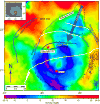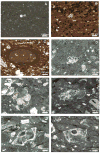Rapid recovery of life at ground zero of the end-Cretaceous mass extinction
- PMID: 29849143
- PMCID: PMC6058194
- DOI: 10.1038/s41586-018-0163-6
Rapid recovery of life at ground zero of the end-Cretaceous mass extinction
Abstract
The Cretaceous/Palaeogene mass extinction eradicated 76% of species on Earth1,2. It was caused by the impact of an asteroid3,4 on the Yucatán carbonate platform in the southern Gulf of Mexico 66 million years ago 5 , forming the Chicxulub impact crater6,7. After the mass extinction, the recovery of the global marine ecosystem-measured as primary productivity-was geographically heterogeneous 8 ; export production in the Gulf of Mexico and North Atlantic-western Tethys was slower than in most other regions8-11, taking 300 thousand years (kyr) to return to levels similar to those of the Late Cretaceous period. Delayed recovery of marine productivity closer to the crater implies an impact-related environmental control, such as toxic metal poisoning 12 , on recovery times. If no such geographic pattern exists, the best explanation for the observed heterogeneity is a combination of ecological factors-trophic interactions 13 , species incumbency and competitive exclusion by opportunists 14 -and 'chance'8,15,16. The question of whether the post-impact recovery of marine productivity was delayed closer to the crater has a bearing on the predictability of future patterns of recovery in anthropogenically perturbed ecosystems. If there is a relationship between the distance from the impact and the recovery of marine productivity, we would expect recovery rates to be slowest in the crater itself. Here we present a record of foraminifera, calcareous nannoplankton, trace fossils and elemental abundance data from within the Chicxulub crater, dated to approximately the first 200 kyr of the Palaeocene. We show that life reappeared in the basin just years after the impact and a high-productivity ecosystem was established within 30 kyr, which indicates that proximity to the impact did not delay recovery and that there was therefore no impact-related environmental control on recovery. Ecological processes probably controlled the recovery of productivity after the Cretaceous/Palaeogene mass extinction and are therefore likely to be important for the response of the ocean ecosystem to other rapid extinction events.
Conflict of interest statement
The authors declare no competing financial interests.
Figures









References
-
- Jablonski D. Extinctions in the fossil record. In: Lawton JH, May RM, editors. Extinction Rates. New York: Oxford University Press; 1995. pp. 25–44.
-
- Schulte P, et al. The Chicxulub asteroid impact and mass extinction at the Cretaceous-Paleogene Boundary. Science. 2010;327:1214–1218. - PubMed
-
- Alvarez LW, Alvarez W, Asaro F, Michel HV. Extraterrestrial cause for the Cretaceous/Tertiary extinction. Science. 1980;208:1095–1108. - PubMed
-
- Smit J, Hertogen J. An extraterrestrial event at the Cretaceous-Tertiary boundary. Nature. 1980;285:198–200.
-
- Renne PR, et al. Time scales of critical events around the Cretaceous-Paleogene Boundary. Science. 2013;339:684–687. - PubMed
Publication types
MeSH terms
Substances
Grants and funding
LinkOut - more resources
Full Text Sources
Other Literature Sources

